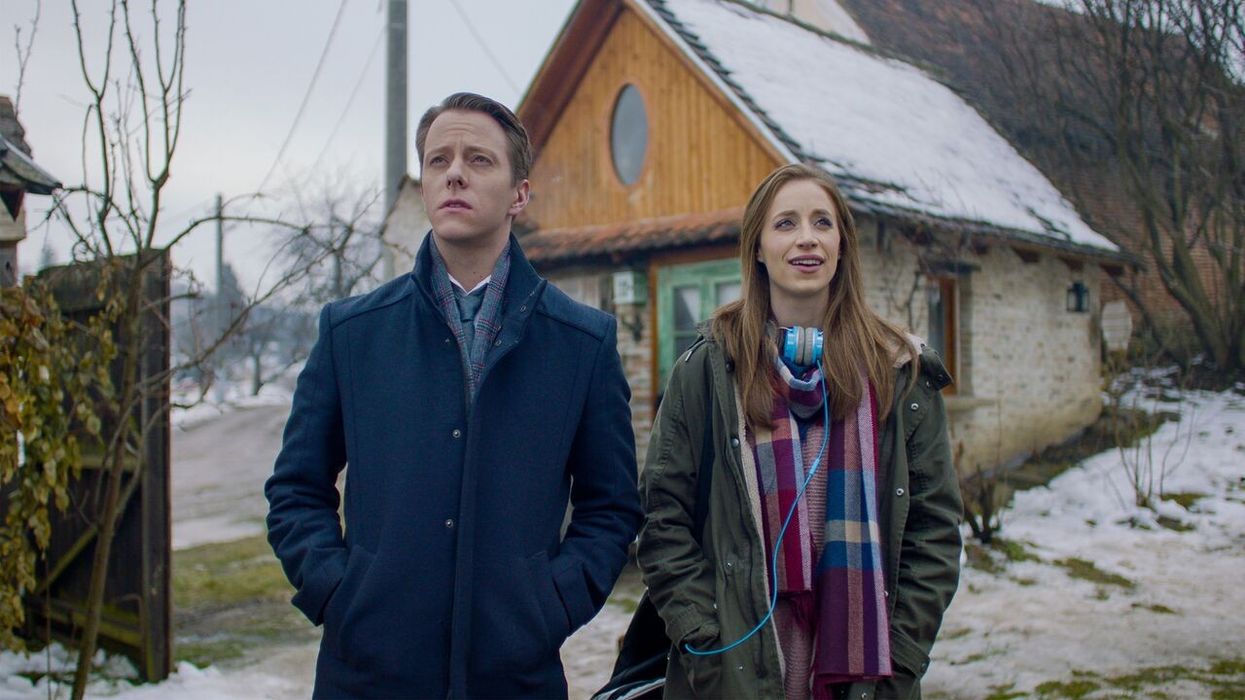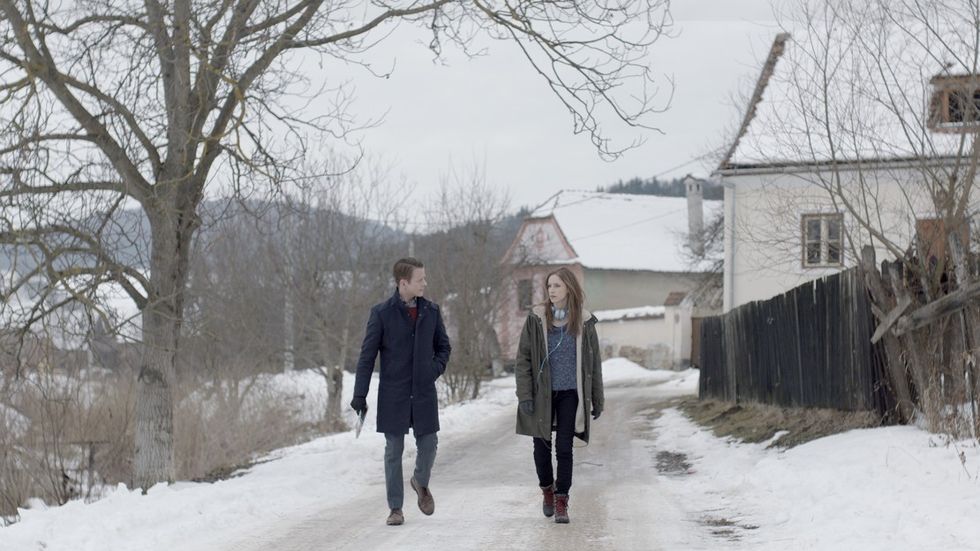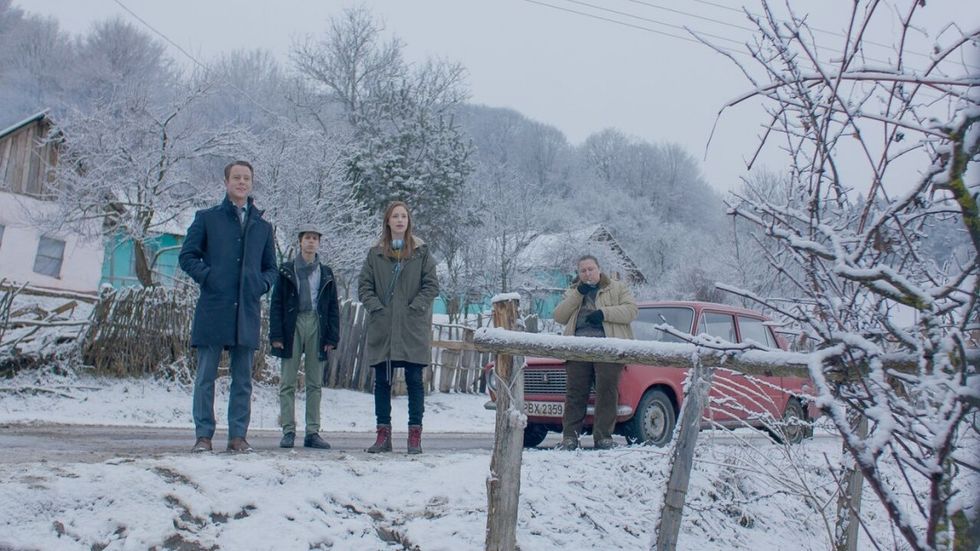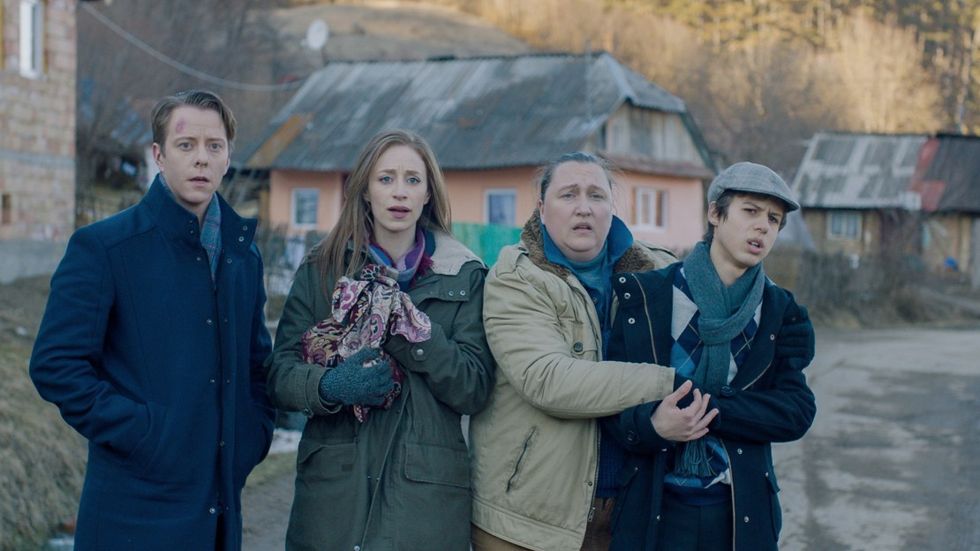'The Dancing Dogs of Dombrova': Why Wintertime in Eastern Europe is Perfect for Absurdist Family Drama
They can bear the cold. They just can't bear each other.

In The Dancing Dogs in Dombrova, grown siblings Aaron and Sarah are sent on a fool's errand to a small town in Poland. They are compelled to go at the urging of their grandmother, their "bubbie," to find her dog. The problem is the dog is dead. The dog has been dead for quite some time. Like, since before the war. But Aaron and Sarah love their bubbie, and would do anything for her. The same, however, cannot be said about their own sibling relationship.
The Dancing Dogs of Dombrova has its premiere this Sat. Oct. 27 at the Austin Film Festival. Prior to AFF, No Film School sat down with the film's director Zack Bernbaum and screenwriter Michael Whatling to talk about the origins of this absurdist drama, casting non-English-speaking actors in English-speaking roles, and using the lack of heated interiors to bring out the best in performances.
NFS: Zack, as I watched the film it felt like a really personal story so I was wondering if you could share with us where the idea for the film originally came from.
Bernbaum: It's very much inspired by my own grandmother, my own bubbie, who actually plays the character for me in the movie. The nugget of the idea started when I was spending time with family. I was at my parents' house and my sister and my brother-in-law's dog was jumping around, and my bubbie said, "Oh, it's dancing." We all had a nice laugh about that, spending time together. And then the evolution of that was, "Oh, it's a dancing dog." And my bubbie being from Dombrova in Poland, the idea became "The Dancing Dog of Dombrova," and I was just like, "That's a cool title." There's something about the alliteration of it, the description of it, that caught my imagination.
I just sat with it for a little while, thinking, "I like the title. But a title isn't a movie." So if I were to move forward with this kind of idea, what is it? And it turned out, as it often does when your brain is turned off, it just came to me, "I feel like there should be a connection to the grandmother in some fashion." From there, I thought, "You know what, make it a brother-sister story. I have a sister, I know that sibling dynamic. What if it's about rediscovering their relationship and their shared past through their grandmother?"
"It's taking the reality of my family and my bubbie's history and fictionalizing it...[to] fit the story that we were trying to tell."
NFS: Michael, what attracted you to the project so that you wanted to come aboard as the writer?
Whatling: Well, I guess if I add something to that, I believe the phone call from Zack was he phoned me up and said, "I was taking a shower and this idea came to me." Do you remember that, Zack?
Bernbaum: I do, yeah. The idea came to me in the shower. You know, as all good ideas should.
Whatling: I thought that was great because you never know where ideas do come to people. But I have to admit, when he called me up and began the conversation with that, I was a bit skeptical and so I said something along the lines of, "Okay..." Like wondering, "Where is this gonna go?" But when he told me the idea, I loved it right away. We have been working together on other things that were very serious subjects. When I talk to people I know about what I write, they're kinda surprised because they tend to think of me more as a funnier kind of guy. When Zack brought up this idea, I really jumped at it cause I thought, "Finally it's a chance for me to be lighter."
NFS: Watching the film, the town of Dombrova feels like another character in the film. Zack, since your bubbie is actually from Dombrova, I was wondering if you and/or Michael traveled to the location to absorb the atmosphere and the create the world of the film, or did you do research ahead of time back home and then go abroad to shoot?
Bernbaum: Basically, not much research was done. It's not an accurate representation of what Dombrova actually is. It's a very fictionalized town that interested us stylistically and creatively. It's not gonna match my bubbie's Dombrova, and I think there are a couple other Dombrovas throughout Poland with different endings [to the towns' names]. We had this very rural countryside village that we had envisioned. So it's taking the reality of my family and my bubbie's history and fictionalizing it and tweaking it and changing it to something that fit the story that we were trying to tell. It's inspired by the name of the place and the history of the place, but it's not an exact replica of it.

Whatling: Zack really gave me a lot of range to go forward, and just do it how I thought worked the best. He gave me the initial idea of what the story should be, and then I did research on Dombrova just to get an idea of the place, but I've never been there. I have been to Eastern Europe, though, so I borrowed from things like that. For our writing process, Zack would let me run with it and then he'd read what I had written, come back and provide really amazing notes. We worked like that until we built the final product.
Bernbaum: A lot of it then comes from location scouting. For example, Michael writes "Interior - Guest House." And we had an idea of what the guest house could be, and you start looking at reference photos during the description stage and you're like, "Okay! I guess these are what guest houses in Eastern Europe look like," but you're not really set because you don't know what the layout of the scene is gonna be. You don't know what the blocking or what the locations that you find are gonna look like.
After location scouting, hopefully we're able to secure our favorite choices to create a cohesive world that these characters inhabit, but that are also visually striking and interesting, because you don't go to Eastern Europe in the middle of winter to make a movie if your locations don't support it.
NFS: So where did you actually shoot the film and why did you choose that particular location?
Bernbaum: We filmed in Romania, mostly in the Transylvania region. The cinematographer Steve Whitehead, who is also a producer on the project, had filmed there before. I brought Steve on board pretty early in the process because we've been working together for about ten years now. He was one of my first calls to see if he was interested in the project, especially since he had experience in Eastern Europe. Steve brought up Romania as a potential shooting location because he knew service providers, production managers and crew in the country that would be able to work with us to get the movie made in that region for the budget we had.
"It definitely added to the feel and the aesthetic and the tone of the movie—no matter where you are, you're always cold!"
NFS: Going to Romania with your DP's connections makes sense, but I also imagine going abroad presents its own challenges, especially when you're shooting an independent feature. What were some of the unforeseen obstacles that you encountered when you were shooting abroad?
Bernbaum: Oddly enough, weather was a big consideration. We did not expect it to be as cold as it was. We were told, "Yeah, Romania is gonna be more moderate and more temperate than even Toronto," which is where I live and it gets pretty cold here in the winter. For the first two or three weeks, it was at least -20 degrees Celsius with a lot of the exterior day shoots and exterior night shoots. Almost all of the locations that we found weren't heated.
The guest house location was actually heated by a fireplace and cast iron stoves that carry the heat through the building. That takes a long time to heat up. The church in the film is only used in the summer because it's way too cold to go in winter because there's no heating. We had probably a pretty even split between interior and exterior shoot days, but most of our interior shoot days felt like you were still outside! So, it definitely added to the feel and the aesthetic and the tone of the movie—no matter where you are, you're always cold! But I think it also helped the actors, it informed their performances and made them feel like they're actually in this foreign place versus if it were warm and cuddly inside.

NFS: So you have a character that you know needs to speak English and you cast somebody that you know does not speak English. What was your thought process behind that choice?
Bernbaum: He auditioned speaking English. Like we knew that he didn't speak English, but he asked, he wanted to audition. He actually came in before we filmed, Steve and I went to Romania for a casting session and location scouting a couple months before we were filming. And he came into the room, auditioned for a different character in English, and he wasn't right for that character but I thought he had a great look and feel for the rabbi. So I asked the casting director, "Do you think he could audition for that?" He was like, "Yeah, but he's going to need some time to prep before the audition because he doesn't speak English."
"Outside of those script words, he doesn't speak a lick of English."
So, in the time after the casting director got in touch with him, his daughter helped him in terms of language, and so when I got a tape of his audition, he was performing in English. I was like, "Okay, you know what, I can work with this." I know that he has the dedication to learn the words and learn the performance and be able to actually give a good performance in that role. And he was perfect. He not only knew his lines, he knew the flow, where they started and where they ended, so he was prepared and was able to actually act off actors performing a language that is not his own.
NFS: Speaking of casting, how did you find the siblings that play Sarah and Aaron at the center of the story, and then how did you also then find the rest of the motley crew of characters that surround them when they go to Dombrova?
Bernbaum: The two leads, Katherine Fogler and Douglas Nyback, are friends of mine. I worked with Doug on a short film a number of years ago, and Katherine and I have been friends for awhile. So when I started to develop the story with Michael, I heard their voices as the characters in my head. I'd be hanging out with Katherine, and just the way she speaks and her accent, her cadence, I was just like, "Oh yeah, this feels like Sarah." I didn't want to do this big casting process, especially since it's a big ask for an actor to go to another country for a month to make a movie.
For me as a director and a producer, I wanted to have a level of trust and comfort with the two leads. And so, if there were people that I didn't know, I'm sure they would've been great as well, but I think the comfort level wouldn't have been as close. Going with Katherine and Doug allowed for a much smoother process. From the second I offered them the parts, they were game and in love with the project and Michael's writing.
For the other actors, they were all Romanian. We cast a lot of them in the October or November before we started shooting. A lot of them are theater actors in Bucharest or Sibiu, so they're trained, talented actors. Each and every one of them blew me away with what they were bringing to the table.

Whatling: Zack was able to put everything together a lot earlier than he originally thought, and it looked like they'd be going to Romania in winter. So that obviously impacted the story. Of course as a writer, when people ask for changes, you're like, "Oh no, not changes." But when it turned out that it was going to be in winter, obviously I had to go back through the whole script and change it to a winter setting. That opened up so many more opportunities that I thought in retrospect added a greater layer to the story, like when Bartek, the boy who has a very unusual relationship with his mother, is building a snowman. Had it been shot any other time of the year, obviously that wouldn't have happened. But I thought that scene, at the end where he actually hugs the snowman gives an interesting bit of poignancy to his character.
Also, when Zack cast Katherine and Douglas, they had questions about their characters after they read the script. The questions that they had were really good questions, that made it obvious to me as the writer that I did not make certain elements clear enough in the script. That allowed me an opportunity to go back and tweak the script so that motivations were clearer.
NFS: What cameras and lenses did you use in the shoot and how did they serve your creative intentions for the story?
Bernbaum: We shot on the ARRI Amira with vintage Canon K35 lenses that our cinematographer actually owns and uses on a number of different projects if they're appropriate. The lenses soften the image, especially at the edges, so it has a little bit more of unique, softer feel, a little bit more filmic in that regard. The style has a very European sensibility to it and the K35s allowed us to push that feel.
"Getting the right tone for the movie makes or breaks the story."
NFS: What were some of the lessons that you learned on this particular project that you will take with you or you've already taken with you onto your next project?
Whatling: In the original draft, the characters were somewhat different. The Sarah character was more buttoned-down, and the Aaron character was more free-wheeling. And what I learned from that was, and I've used it in other scripts I've written, is the idea that, sure, you write it one way, but then you sit down and say, "But what if it wasn't this way? What if the characters were the opposite or different, or this character was more like this one, this one was like another one?" Just to think outside the box and ask yourself, "Does that bring more to the table? Does that make a deeper character? Does that make something that is not so common, something that you haven't seen in every other movie?" And I find that's a very successful thing that I've certainly learned from writing this.
Bernbaum: One of the most essential and important things that I think a director needs to bring is tone. Getting the right tone for the movie, I think, makes or breaks the story. Making sure that everybody working on the project is working in service and towards a common tone. This movie in particular is an absurdist drama, and that's what I'm pitching people on. That's the style, that's the tone, that's the look. From performance to editing choices to music, the writing, shot selection, everything needs to be in service of a consistent tone. Because of the unique tone of this film, it makes me think of tone when looking at other scripts or directing other projects to make sure that I'm approaching those projects correctly and then making sure that the key players involved are all on the same page.
'The Dancing Dogs of Dombrova' premieres at the Austin Film Festival in its Comedy Vanguard section on Saturday, Oct. 27 at 9:30 pm at Bethell Hall, St. David's Episcopal Church.












